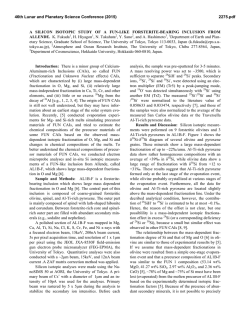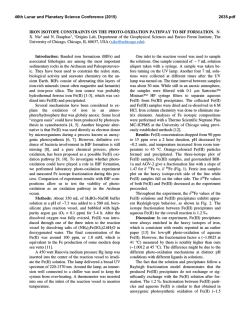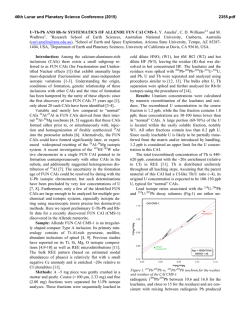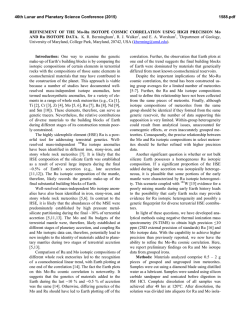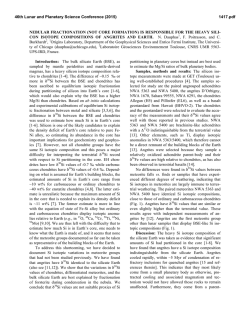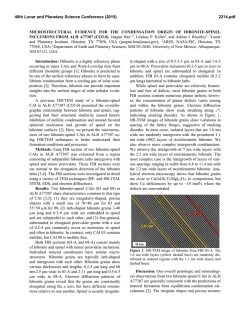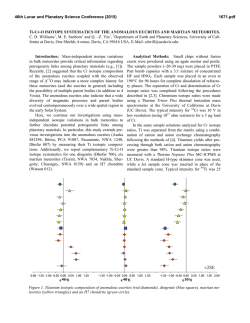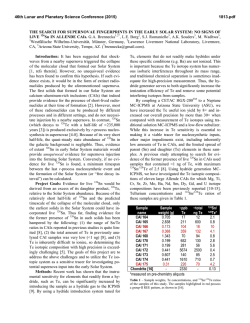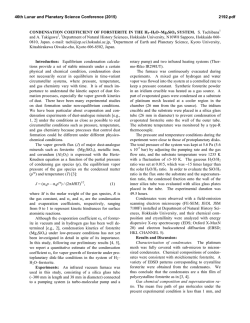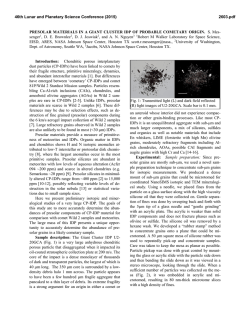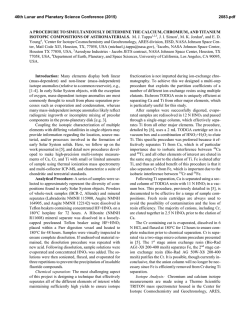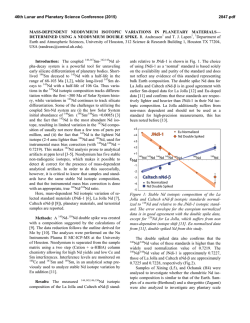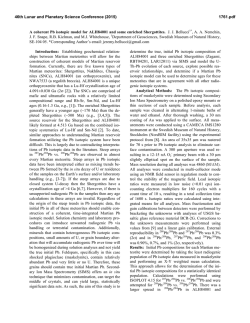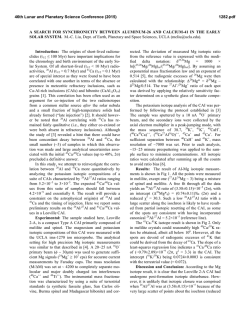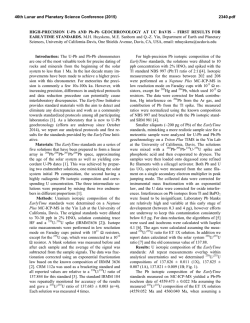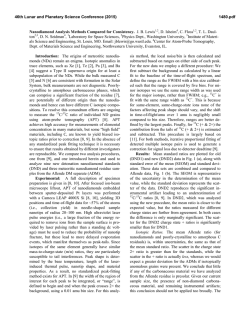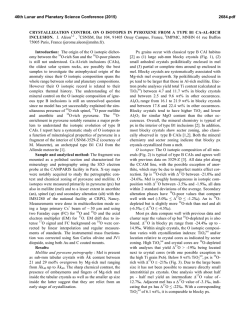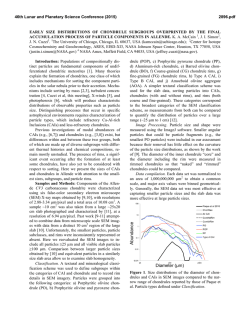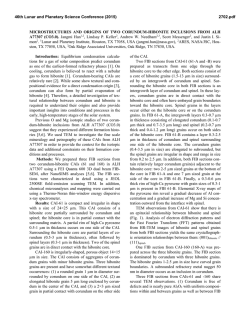
COMPARING MEASURED AND MODELED Ti - USRA
46th Lunar and Planetary Science Conference (2015) 2472.pdf COMPARING MEASURED AND MODELED Ti ISOTOPE FRACTIONATION IN CAI SJ101 AND IMPLICATIONS FOR THE ORIGIN OF CAIs. M. K. Jordan1, I. E. Kohl 1, E. D. Young1, J. I. Simon2, S. B. Jacobsen3. 1Department of Earth, Planetary, and Space Sciences, University of California, Los Angeles, CA, USA, [email protected], [email protected], 2Center for Isotope Cosmochemistry & Geochronology, NASA-JSC, Houston, TX, USA, 3Department of Earth and Planetary Science, Harvard University, Cambridge, MA, USA. Introduction: Calcium-aluminum-rich inclusions (CAIs) are the oldest surviving solids to have formed in the Solar System. Their chemical and isotopic compositions provide a record of the conditions present in the protoplanetary disk where they formed and can aid our understanding of how solids formed in the solar nebula, an important step in the eventual process of planet building. The isotopic compositions of CAIs are primarily controlled by volatility. The isotopic effects of evaporation/sublimation are well understood through both theory and experimental work to produce an enrichment in the heavy isotopes of an element, less is understood about the effects of condensation. Massdependent fractionation can potentially provide a record of nebular condensation. Our ability to assess whether CAIs are primary condensates from a solar gas or evaporative residues of chondritic material will place important constraints on the formation of these primitive solids. Measuring the Ti isotopic composition of CAIs is a useful tool for increasing our understanding of condensation since Ti is not likely to experience evaporation due to its refractory nature. Using Ti to understand the isotopic effect of condensation will also allow us to better assess the initial isotopic ratios of the more volatile Mg and Si prior to evaporation. Here, we present a model for condensation and explore its isotopic consequences. Developing selfconsistent models for Mg, Si, Ca, and Ti and comparing these models to measurements of CAIs allows us to better understand the effects of condensation and the formation history of these objects. Sample Description: We measure Ti isotope ratios in CAI SJ101 for which Mg and Si ratios have previously been measured [1]. S101 is a large forsteritebearing type B (FoB) CAI from Allende. The object exhibits neither petrological nor isotopic evidence for evaporation [2]. It has negative δ25Mg, δ29Si, and δ44Ca values relative to chondritic, thus lacking the heavy isotopic enrichment common in other igneous CAIs [1,3]. Analytical Methods: In-situ analyses were conducted using laser ablation multiple-collector inductively coupled plasma-source mass spectrometry (LAMC-ICPMS, ThermoFinnegan NeptuneTM). We used a 193 nm excimer laser to extract Ti from the sample. The laser was operated at a UV fluence of 28 J/cm2. Material was ablated at a pulse repetition rate of 3 Hz, using a spot size of 172 µm for SJ101. Helium (0.29 l/min) carried ablated material from the sample chamber to a mixing chamber where it combines with Ar (0.6 l/min) before being introduced into the ICP torch. The mass resolving power was ~7000 and samplestandard bracketing was used to correct for instrumental mass bias. 49 Ti/47Ti is essentially free from nuclear anomalies at the 0.1‰ level or greater [4,5]. Comparing our UCLA Glass #5 standard against pure TiO2 allows us to demonstrates the lack of matrix effects on 49Ti/47Ti within our current analytical precision of ~0.15-0.2‰. Data: δ49Ti is reported relative to UCLA Glass #5, which is taken to be chondritic based on previous analyses. For CAI SJ101, the average δ49Ti = 0.055 ± 0.117‰ (1σ). SJ101 displays no detectable fractionation relative to the normal stable isotope ratio. Stable isotope ratios for Ca, Mg, and Si will also help in our assessment of the Ti data. Previously measured values for SJ101 are: δ44Ca = -3.5 ± 0.05‰, δ25Mg = -2.0 ± 0.5‰, and δ29Si = -0.2 ± 0.2‰ relative to chondritic [1,3]. All these values display an enrichment in the lighter isotopes of the respective species. Theory: We consider the isotopic consequences of condensation from a nebular gas in terms of the kinetics of condensation, the degree of undercooling, and potential reservoir effects. While we can directly measure fractionation factors for evaporation (αevap), this is not the case for condensation fractionation factors (αcond). Instead, a condensation model is needed to indirectly obtain αcond. Invoking the law of mass action, we have [7]: 𝛼eq = 𝛼cond 𝛼evap Equilibrium fractionation factors can be calculated allowing us to solve for αcond [7]. Kinetic fractionation associated with condensation depends upon collisional frequency and the ability of a molecule to incorporate into the structure of the condensed phase [7]. Collisional frequency favors the lighter isotopes to the condensates. The degree of saturation controls the relative contributions from equilibrium and kinetic isotope frac- 46th Lunar and Planetary Science Conference (2015) tionation [8]. The saturation index Si = Pi/Pi,eq quantifies the degree of saturation with Si > 1 implying condensation. Si can be equated with a temperature difference from the equilibrium condensation temperature using the Van’t Hoff equation and the enthalpy for the condensation reaction. Therefore, Si corresponds to the degree of undercooling [9]. Combining these parameters we arrive at a complete model for fractionation associated with condensation [7,8,9]. 𝛼cond = 2472.pdf indicates that CAIs reflect a blend of pre-existing material derived from various compositionally distinct reservoirs. 𝛼eq 𝛼kin Si 𝛼eq (Si − 1) + 𝛼kin where, 𝑚𝑖 𝛼kin = 𝛼evap 𝛼eq √ ′ 𝑚𝑖 with mi being the mass of the lighter isotope of the species of interest and mi’ being mass of the heavier isotope. In addition to the kinetic isotope effects, our model also account for reservoir effects, such as those resulting from Rayleigh distillation. Discussion: The expected shifts in isotopic ratios as a function of oversaturation, Si, are calculated for Mg, Si, Ca, and Ti isotope ratios using our condensation model, published evaporative fluxes, gas-solid equilibrium factors, and experimentally determined evaporation fractionation factors. Due to their similar volatilities, we expect that Ca and Ti experienced similar degrees of undercooling and predict that for the measured δ44Ca of -3‰ [3], δ49Ti should be ~-1‰. Instead, the data show that there is no discernable fractionation and thus, a lack of correlation with δ44Ca (Figure 1). The lack of correlation implies that the Ti and Ca in this object did not experience the same condensation history and that Ti was inherited from a different reservoir. The presence of distinct reservoirs for these elements suggests that CAIs are aggregates of pre-existing materials as opposed to being original condensates. The lack of correlation between δ25Mg and δ29Si (Figure 2) further supports this conclusion since these two elements are also expected to experience similar degrees of undercooling. Modeling predicts that δ29Si should be lower assuming that the low δ25Mg value is due to condensation. Note that ε50Ti measured for several CAIs at the UCLA laboratory by LA-MC-ICPMS displays a limited range of values and seem to fall around the typical value of ε50Ti = +10, despite the object having a lack of correlation between both δ25Mg and δ29Si as well as δ44Ca and δ49Ti. This nucleosynthetic excess further Figure 1. Correlation between δ44Ca and δ49Ti as a function of oversaturation (Si) calculated from the condensation model with LA-MC-ICPMS data for CAI SJ101 plotted. Figure 2 Correlation between δ25Mg and δ29Si as a function of oversaturation (Si) calculated from the condensation model with LA-MC-ICPMS data for CAI SJ101 plotted. References: [1] Jordan M. K. et al. (2013) LPS XLIV, Abstract #3052. [2] Petaev M. I. and Jacobsen S. B. (2009) LPS XXXI, Abstract #1388. [3] Huang S. et al. (2012) GCA, 77, 252-265. [4] Zhang J. et al. (2011) JAAS, 26, 2197-2205. [5] Williams, N. H. et al. (2014) LPS XLV, Abstract #21831. [7] Young E. D. and Schauble E. A. (2012) MetSoc, Abstract #5382. [8] Simon J. I. and DePaolo D. J. (2010) EPSL, 289, 457-466. [9] Jouzel J. and Merlivat L. (1984) JGR, 89, 1749-1757.
© Copyright 2026
